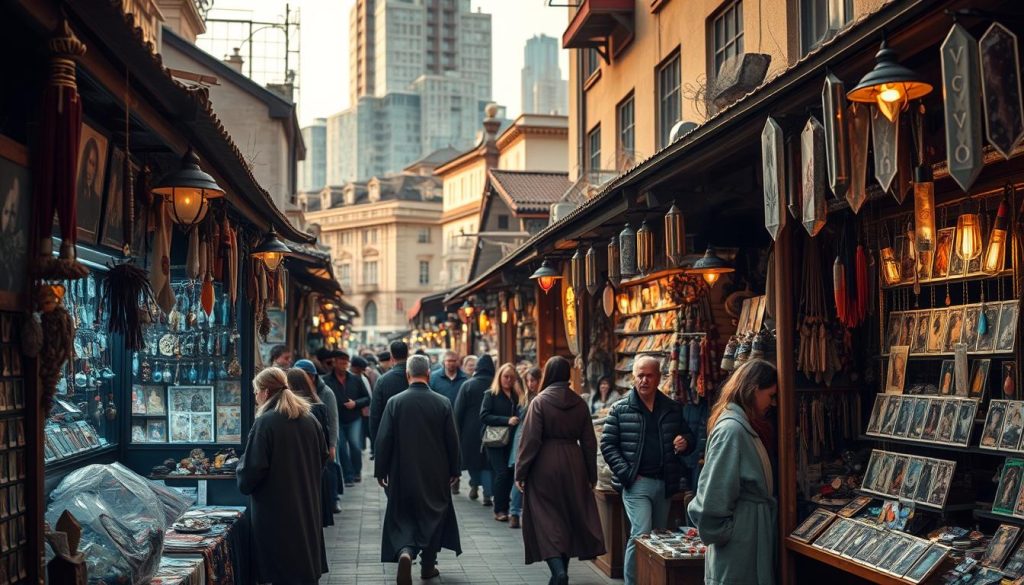We open 2025 with a friendly map of a practice that has moved from niche shops into apps and kitchen tables. After lockdowns, places like London’s Treadwell’s saw work spike, and U.S. market data shows growing interest in intuitive services.
Here, the focus is simple: small rituals that help people find clarity, calm, and creative solutions in busy times. People pull a single card before a meeting, journal after a tough chat, or set a theme for the week.
In this article we trace history to habit, business to community, and show why more people are turning to this practice today. Expect practical tips, cultural context, and ideas to fit the always-on, mostly-mobile world.
Treat this piece like a compass: skim for quick cues or dive deep when you want strategy and meaning.
From Renaissance Courts to TikTok Lives: How Tarot’s Past Informs Today’s Boom
What began as an ornate pastime in Italian courts now lives in museum galleries and pocket apps. In 15th-century Milan, gilded decks were a luxe courtly game; the original rules mostly vanished with time.

Origins, archetypes, and the long arc
Over centuries French occultists reframed the decks into a system of divination, sometimes inventing exotic origins. Modern study rejects those myths while honoring a real evolution.
We trace the 22 Major Arcana and 56 Minor as archetypal images. Death reads as change, the Hanged Man as pause, the Moon as inward work. Symbols act as mirrors for choices and feeling.
Exhibitions, archives, and scholarly reappraisal
Shows like the Warburg Institute’s “Origins and Afterlives” map the visual story from Renaissance painting to Austin Osman Spare and the Thoth deck. Here, arts and research meet.
We invite a small ritual: handle your deck with curiosity, remember its long history, then ask one clear question before you shuffle. It turns image into insight—and practice into a living link across the world.
Tarot Trends 2025: How Modern Readers Are Using Cards for Daily Guidance
Numbers tell a lively story: roughly one in five people in the U.S. have tried a fortune-teller, medium, or psychic at least once. This study snapshot shows curiosity is broadening into habit.
Women lead engagement, and younger cohorts push the curve. Gen Z brings new formats — quick streams, micro readings, and playful prompts that fit busy lives.
Belief and behavior can diverge. Pew research notes that about six in ten adults accept a new-age idea. That openness helps explain why light-touch daily pulls feel normal now.
Cross-border numbers add color: in Canada nearly half say some people can see the future. These differences hint at cultural flavors while the overall pattern shows steady growth.
What it means in practice: a tarot card reading or quick card reading often starts as a gateway. People use it to reflect on work, relationships, and small decisions. Treat a pull as a sign for a micro-adjustment, not an ultimatum.
We see spiritual practices becoming part of a personal toolkit — creative, reflective, and practical for our times.
How People Actually Use Tarot Now: Sessions, Check-ins, and Reading Frequency
Many people mix quick pulls with deeper sessions, building a personal tempo that fits work and life.

Snapshot from recent study data shows most users check in less than once a month to several times a month. UK Mobilesquared reports nearly 400,000 people use services several times a week, and about 100,000 check daily.
Across Sweden and France, YouGov and IFOP find horoscope habits mirror this pattern: occasional engagement (twice a month to twice a week) is common, not daily rituals.
Simple cadences that work
Try one reflective reading per week, a midweek single-card check, and a once-a-month spread for bigger themes. This structure fits busy schedules and honors ebb and flow.
Some months you do a lot of small pulls. Other months you prefer one longer session. Both are productive.
Seasoned readers recommend boundaries: limits on session frequency prevent dependency and keep seeking guidance healthy.
Practical tip: note the date-of-month in a notes app. Over time patterns appear. Content creators can time drops for Sunday night prep and month starts, meeting people when they’re most receptive.
The Business of Cards: Market Size, Services, and Professionalization in the U.S.
The U.S. market for intuitive services has shifted from informal hustles to a visible, revenue-driving business.

Numbers show steady growth: since 2005 the sector rose about 52%, reaching roughly $2.2B in 2021. That expansion matters because more people find access through apps, events, and local studios.
Where money sits: general practice accounts for roughly 45% of revenue, mediums about 25%, spiritual healers 15%, and niche pet services 15%. The market is fragmented; no firm controls more than about 5%.
Most practitioners are freelancers. That creates a business landscape driven by personal brand and repeat clients. Fees per session can be high, but many readers keep hours limited to avoid burnout.
Professional expectations and smart operations
Ethics, training, and client limits matter. Many pros cap clients to one session a month and invest in mentorship or certifications. This builds trust and sustainable practice.
Practical templates: limit back-to-back sessions, offer monthly check-ins, add bundles like card reading plus journaling, and track retention by month. Collaboration with astrologers or sound therapists opens new revenue lanes.
For creators and brands, this is a market of careful growth. Honor the practice, protect reader wellbeing, and design services that help people reflect without noise.
From Fear to Framework: Shifting Perceptions from Fortune-telling to Intuition
People increasingly treat the deck as a mirror, not a prediction engine. We see contemporary voices framing this practice as a way to surface inner answers and strengthen intuitive ability.
Scholars and practitioners note roots in northern Italy, and exhibitions like the Warburg show how imagery invites reflection over prophecy. Janine Worthington reminds us context matters: origin is historical, not spooky.
Try this gentle method: pull a tarot card and ask, “What is the next wise step?” Journal bodily and mental reactions. Track small shifts in mood and choice.
We make space for uncertainty. Cards do not erase doubt, but they reveal options and timing that fit real life. Ethical norms — scope limits and referrals — keep people safe and respected.
In short: this grounded spirituality reframes a tool into a weekly ritual. It builds self-trust and helps people turn insight into compassionate action.
Phones, Apps, and Social Media: How Daily Guidance Fits Modern Life
Phones and feeds now tuck small rituals into spare minutes. We see one-card pulls over coffee and a quick horoscope scan at noon. These micro-moments help people pause without slowing the day.
Micro-readings on the go
An app ping can prompt a tiny reflection. A short card reading on your phone becomes a steady habit. Social media clips show simple spreads and duet interpretations that teach and inspire people.
Turning insight into action
Make each reading useful. Tag a pull with one small task—send the email, take a walk, ask a question. That turns insight into movement.
Healthy limits matter: mute notifications when you need focus. Reflect before sharing a private pull. Use journaling flows and calendar sync in your app to track patterns over time.
We suggest a simple cadence: one deeper reading on Sunday, micro-checks midweek, and a weekend recap. This keeps spiritual practices playful, private, and practical for individuals today.
What the Cards Signal Next: Key 2025 Takeaways for Readers, Seekers, and Brands
Looking ahead, small rituals are set to blend deeper purpose with everyday life.
We expect steady growth as women and younger cohorts deepen interest. Market signals and a broad study show participation stays wide. That means practical formats win: short nudges with clear value, plus opt-in moments for deeper work.
Build hybrids: live tarot readings plus app prompts. Mix horoscope and divination features with consent and context. Honor the arts lineage and pay creators fairly. Make ethics visible—boundaries and resource links build trust across the world.
Keep it simple: ask one question, pull one tarot card, take one action. That tiny loop creates real change in life over time. Treat this as an ongoing experiment, not a command. The future favors gentle, useful insight and humane design.
